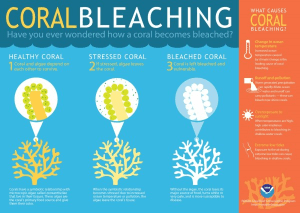TAG: GS 3: ECOLOGY AND ENVIRONMENT
THE CONTEXT: The fourth global mass coral bleaching event has been triggered by extraordinary ocean temperatures, the US National Oceanic and Atmospheric Administration (NOAA) said recently.
EXPLANATION:
Corals:
- Corals, often mistaken as plants or rocks due to their stationary nature, are actually living animals.
- They belong to the phylum Cnidaria and class Anthozoa. These sessile organisms permanently attach themselves to the ocean floor, forming colonies of genetically identical polyps.
- Each individual polyp has a cylindrical body surrounded by tentacles used for feeding.
- Corals come in two main types: hard corals and soft corals. Hard corals, such as those belonging to the genus Acropora, build the intricate limestone skeletons that form coral reefs, while soft corals lack this rigid structure.
- Coral reefs are diverse underwater ecosystems built by the accumulation and growth of coral colonies over thousands of years.
- They are often referred to as the “rainforests of the sea” due to their extraordinary biodiversity and importance in supporting marine life.
- The Great Barrier Reef in Australia, spanning over 2,000 kilometers, stands as the largest coral reef system globally.
- Coral reefs host a vast array of marine species, including fish, mollusks, sea turtles, and countless others, making them one of the most biologically productive ecosystems on Earth.
Significance of Corals and Coral Reefs
- Coral reefs play a crucial role in marine ecosystems by providing habitats for thousands of marine species.
- The intricate structures of coral reefs offer shelter, breeding grounds, and feeding areas for various organisms, contributing to the rich biodiversity found in these environments.
- Research suggests that coral reefs may harbor millions of undiscovered species, underscoring their significance in global biodiversity.
- Beyond their ecological importance, coral reefs provide substantial economic benefits to human societies.
- The ecosystem services provided by coral reefs, such as fisheries, tourism, and coastal protection, are estimated to be worth approximately $375 billion annually.
- Over 500 million people worldwide rely on coral reefs for sustenance, livelihoods, and protection from natural disasters like storms and floods.
Coral Bleaching
- Corals maintain a symbiotic relationship with tiny photosynthetic algae called zooxanthellae, which reside within their tissues.
- These algae provide corals with essential nutrients through photosynthesis while receiving shelter and nutrients in return.
- The symbiotic algae also impart vibrant colors to the corals, contributing to their visual appeal.
- Coral bleaching occurs when corals expel their zooxanthellae due to environmental stressors, such as elevated sea temperatures, pollution, or changes in water chemistry.
- Without the presence of zooxanthellae, corals lose their vibrant colors and appear white or pale. While coral bleaching does not immediately result in coral death, it increases their susceptibility to mortality and reduces their reproductive capacity.

Current Global Mass Coral Bleaching Event
- The ongoing fourth global mass coral bleaching event, triggered by unprecedented ocean temperatures, is affecting coral reefs worldwide.
- Nearly 54% of the world’s coral area has experienced bleaching-level heat stress, with the Great Barrier Reef witnessing particularly severe bleaching.
- Bleaching has been confirmed in various regions, including the Western Indian Ocean and the Caribbean Sea, affecting marine ecosystems and coastal communities.
- The primary driver of the current bleaching event is rising ocean temperatures exacerbated by climate change.
- While events like El Niño can intensify bleaching episodes, the long-term trend of global warming poses a significant threat to coral reef ecosystems.
- Scientists warn that if global temperatures continue to rise unchecked, the majority of the world’s coral reefs could perish, leading to devastating consequences for marine biodiversity and human societies that depend on reef ecosystems.
Mitigation and Conservation Efforts:
- Mitigating the impacts of coral bleaching requires urgent global action to address climate change and reduce greenhouse gas emissions.
- The Paris Agreement’s goal of limiting global warming to 1.5 degrees Celsius is crucial for safeguarding coral reefs and marine ecosystems.
- Achieving this target necessitates ambitious measures to transition to renewable energy sources, enhance carbon sequestration, and promote sustainable land and ocean management practices.
- In addition to climate mitigation efforts, conservation strategies focused on reef resilience and adaptation are essential for protecting coral reefs.
- These include measures such as marine protected areas, sustainable fishing practices, coral restoration initiatives, and reducing local stressors like pollution and overfishing.
- Collaborative efforts involving governments, scientists, local communities, and stakeholders are critical for implementing effective conservation measures and safeguarding the future of coral reef ecosystems.

